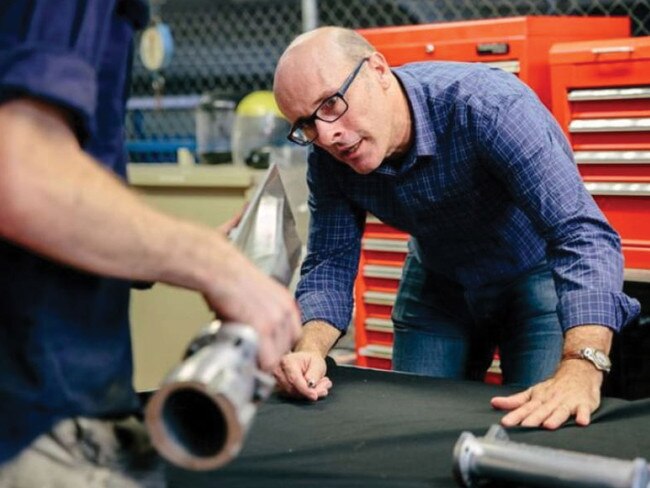Hypersonix eyes cheap, cheerful Mach 12
In the race to be the first to fly from Sydney to London in just a couple of hours, Australia might be the winner.

In the race to be the first to fly from Sydney to London in just a couple of hours, Australia might be the winner. But it’s unlikely to happen for a while yet, according to Dr Michael Smart, co-founder and chief technology officer of Sydney-based Hypersonix Launch Systems.
His company is taking baby steps towards that goal, starting with a contract from the Pentagon’s Defense Innovation Unit for the HYCAT, or Hypersonic High-Cadence Airborne Testing, program to simply test lots of hypersonic sensors and navigation systems – and do so quickly.
Hypersonic speeds are greater than Mach 5. The Hypersonix DART platform which will be used in the HYCAT program will fly up to 1000km at Mach 7, or for less than seven minutes.
“The US has fallen way behind both Russia and China in the frequency of hypersonic testing that’s occurring,” he says. “The US has a couple of tests a year, they probably cost $US100m ($150m) each.”
The American aerospace community wants to test as frequently as once a week to try and catch up. That means reducing the cost of a test flight by an order of magnitude – to $15m and less.
Hence the HYCAT project. To win that contract Hypersonix Launch Systems had to beat off competition from 63 other rivals.

The first launch of a DART platform, funded jointly by the DIU and an $8m Modern Manufacturing Initiative (MMI) Grant from the Australian Department of Industry, Science and Resources, is scheduled for March next year. It will cost about $20m and take place at NASA’s Wallops Island maritime range near Washington DC. Over three years Hypersonix could build to one launch a month.
The DART is a single-use vehicle, 3m long and 3D printed. It is actually Hypersonix’s Minimum Viable Product (MVP), says Smart, and is a technical stepping stone to something bigger and better.
The company’s core technology is the Spartan scramjet, or supersonic combustion ramjet. Designed by Smart himself, this is the world’s first fixed-geometry scramjet: it has no moving parts, it runs on hydrogen fuel and can operate from Mach 5 to Mach 12. Thrust levels aren’t meaningful for such motors. The key measure is Specific Impulse which, at about 2000 seconds, is five times better than any rocket motor, he says.
Spartan has undergone more than 11 suborbital test flights and 6000 ground tests at the University of Queensland, which launched the world’s first successful hypersonic vehicle at Woomera in 2002.
At hypersonic speeds the Spartan engine uses shockwaves and careful internal shaping to compress the fuel-air mixture and generate thrust. It is also 3D printed. “3D printing enables you to scale up quickly and also to make complex things cheaply,” he explains.
The DART is powered by a single Spartan engine and will be boosted to Mach 7 by a Rocket Lab Electron launcher in the DIU’s HASTE (Hypersonic Accelerator Suborbital Test Electron) mission, at which point the scramjet will ignite and take over. It has a 9kg payload so can carry things such as computers, sensors, communications and navigation systems for companies that need hypersonic flight validation.

A cadence of five to 10 flights a year would generate significant revenue to plough back into the business, says Smart. Developing the DART and Spartan engine has cost about $20m over four years, he reckons. The next stage, developing the much bigger, reusable VISR hypersonic aircraft that uses four Spartan engines, could cost double that.
There is a technology leap involved: DART is made from the high-temperature nickel-chromium Inconel alloy, which is good to about Mach 7, or about 5000km/h. To handle greater friction-generated heat up to Mach 12, VISR and its Spartan engines will be 3D printed from ceramic matrix composites, or CMCs. And unlike DART, which has no undercarriage, the 8m-long VISR has a retractable undercarriage and is designed to be reusable.
VISR, which stands for Velos Intelligence, Surveillance and Reconnaissance, has a 2500km range, 100kg payload and is designed for the high-cadence military reconnaissance market, or for high-value cargo, as well as to provide flight heritage for equipment and materials manufacturers. For example, hypersonic craft could suffer from the same communications problems that afflict space capsules on re-entry: VISR is an opportunity to explore this problem.
And VISR in turn is a stepping stone towards Delta Velos which is designed to carry rockets economically up to the edges of space at Mach 12 so they can then position satellites in low-earth orbit.
Why use hydrogen as a fuel?
“In order to fly above Mach 6 you need hydrogen,” says Smart. “Hydrogen has the highest chemical energy per kilogram of any fuel.”
Kerosene-powered hypersonic cruise missiles are limited to a maximum speed of about Mach 5. For Hypersonix’s missions much higher speeds are necessary.
Dr Michael Smart started his working life at the University of Queensland, working for Professor Ray Stalker who pioneered much of today’s hypersonic technology and was the first in the world to design a successful scramjet. He then spent 10 years in the scramjet group at NASA’s Langley research centre before returning to UQ and, eventually, a professorship.
In Brisbane he co-ordinated the joint Australia-US HiFIRE hypersonic scramjet program and then founded Hypersonix Launch Systems in 2019 with Sydney-based David Waterhouse.
“We have 42 staff now, 30 in the engineering team,” says Smart.
“I’d expect by the end of the year we’ll be at about 50.
“We’re a small company, we’re scaling up, we don’t have all of the overheads and cost structures that large companies have, we can make decisions quickly.
“And we’re not trying to develop the Ferrari solution – we’re trying to develop the cheap and cheerful solution.”


